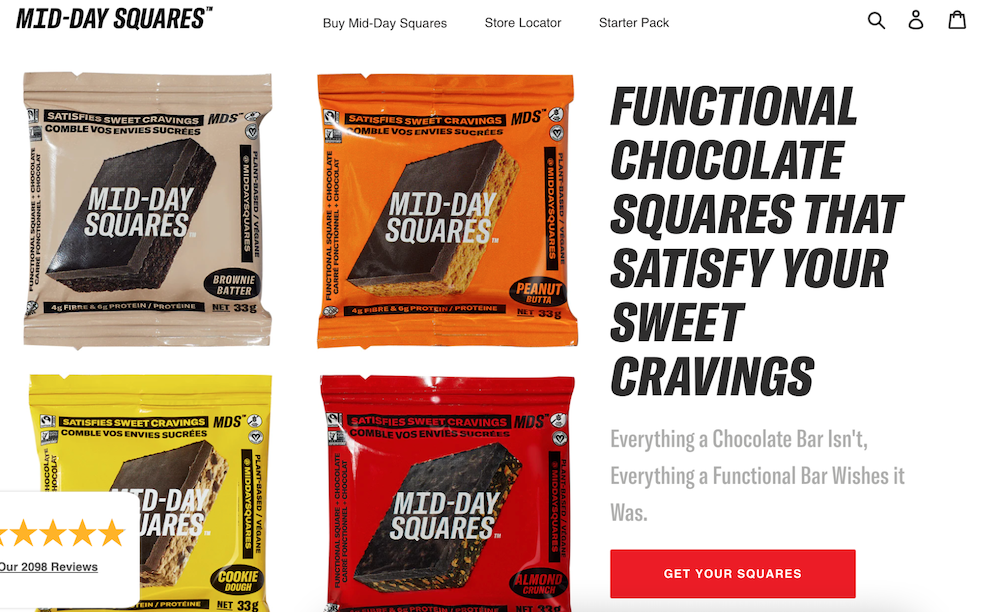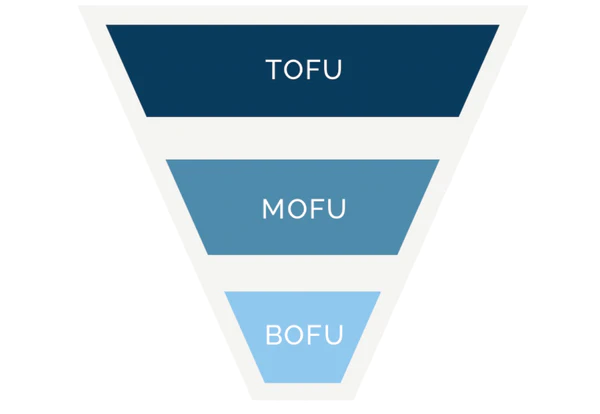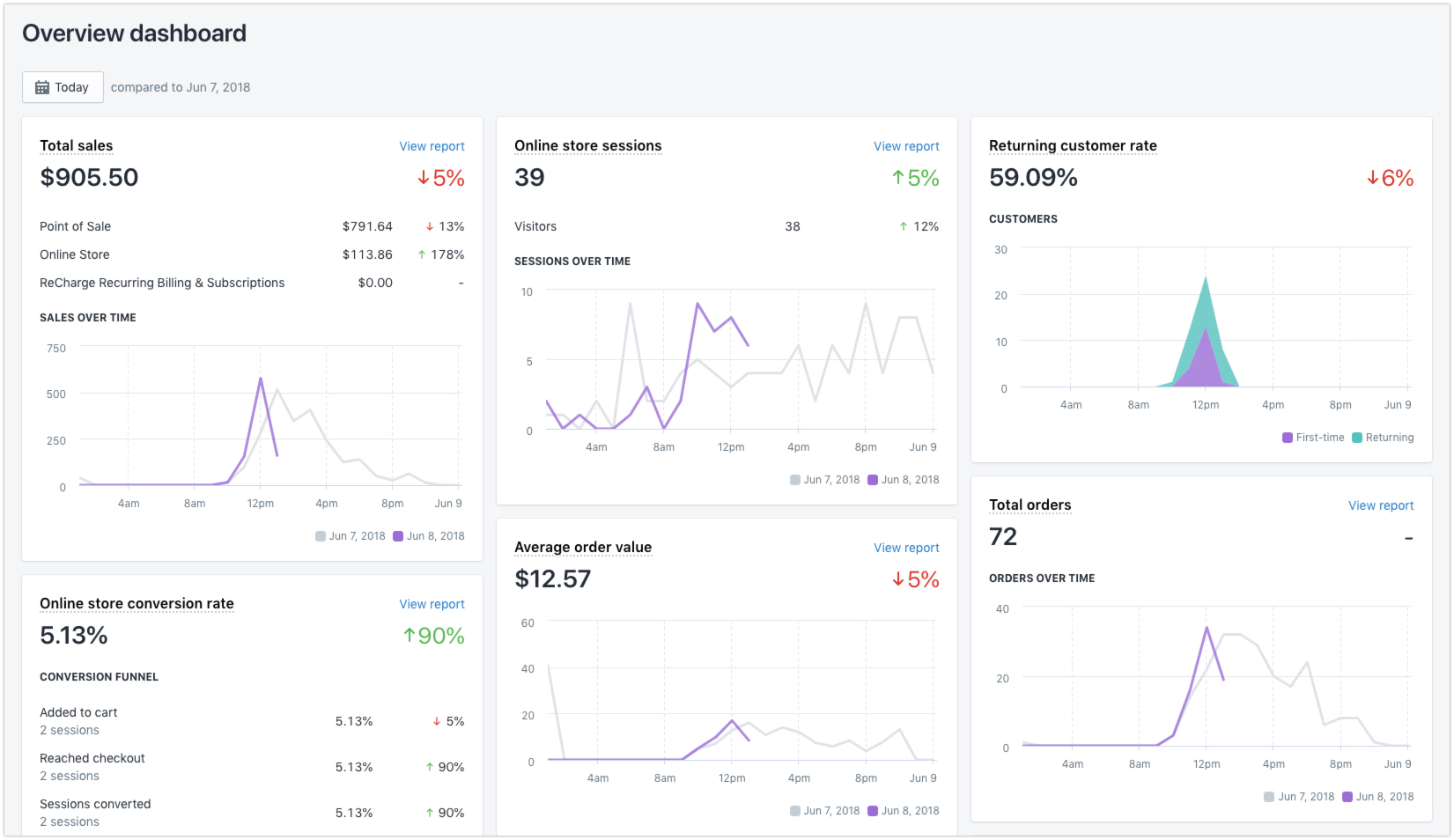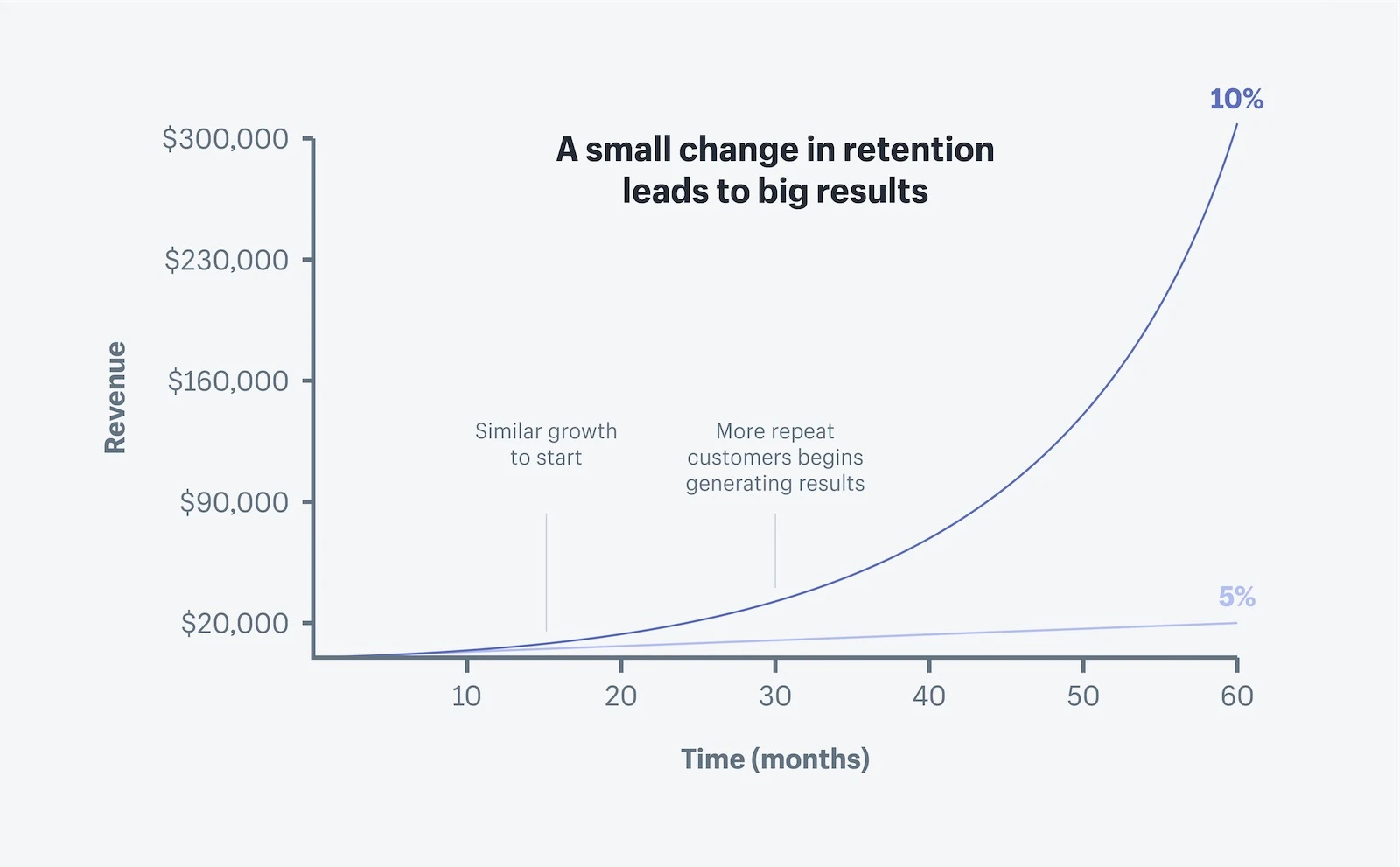No matter how much you stick to a plan, things go wrong. As the famous quote by US President Dwight D. Eisenhower goes: “Plans are useless, but planning is indispensable.”
When it comes to ecommerce, consumer trends shift, circumstances change, and initial experiments don’t always go as planned. All of these things impact your marketing plan.
Research shows that marketers who proactively write a marketing plan are 356% more likely to report success. So, what does a realistic ecommerce marketing plan look like? And how do you handle unexpected obstacles and overestimations that threaten your company’s marketing strategy? This guide shares the answers.
What is a marketing plan?
A marketing plan is the strategy a business uses to get its products or services in front of its target customer. It includes who the target market is, the channels used to reach them, and the messaging that will help the business sell its products.
The purpose of a marketing plan isn’t to create a step-by-step, never-fail manual. Rather, it’s a roadmap to help you accomplish the best-case scenario, while also maintaining realistic expectations for your marketing initiatives and establishing backup plans if something doesn’t work.
Marketing plan vs. business plan
A business plan paints a bigger picture of how you plan to run your business. It includes a mission statement, products you’ll launch, and market research. A marketing plan, on the other hand, is a specific document that details how you plan to achieve these wider goals through marketing.
Marketing plan vs marketing strategy
An overarching marketing strategy details how marketing will drive business results. A marketing plan is the route you’ll use to get there. It’s more specific than a strategy and includes a practical roadmap on how you’ll put your marketing activities into play.
Free marketing plan template to help you get started
Creating your own marketing plan is no small job. You put hours into customer and competitor research to find the channels likely to have the biggest impact on your marketing goals. You can check out marketing plan examples, but when it comes to creating your own, you can save time with a template.
Ditch the intimidating blank screen by building a marketing plan using Shopify’s free marketing plan template. Use it to guide your marketing strategy, tweaking the template to meet your business needs.
Types of marketing plans
Digital marketing plan
A digital marketing plan is a specific type of marketing plan that revolves solely around online channels like social media, email, and search engines. It doesn’t include offline channels like billboards or radio ads.
Social media marketing plan
A social media marketing plan focuses specifically on how a business will use social media to reach its target market. It gives you a framework of which channels you’ll use, the types of content you’ll create, whether you’ll invest in social media ads, and how you’ll drive product sales. This can take place either through your online store or a social media storefront such as Facebook and Instagram Shops.

Content marketing plan
A content marketing plan details how you’ll produce content that turns people into paying customers. This can span multiple formats, including an email newsletter, infographics, product documentation, and user-generated content (such as social media posts).
Alongside the more traditional elements of a marketing plan, a content-marketing-specific strategy would include:
- Keywords you plan to target
- Who you’ll use to create the content (e.g., freelancers or in-house marketers)
- How you’ll promote and repurpose your content
Offline marketing plan
An offline marketing plan details how a business will reach its target market without using digital channels. This might include billboards, radio ads, direct mail, event sponsorships, and outdoor advertising.
How to write a marketing plan
- Detail your unique value proposition
- Outline your buyer personas
- Run a SWOT analysis
- Detail product features and benefits
- Set key performance indicators
- Outline your marketing funnel
- Define your marketing channels
- Decide on your content formats
- Plan your marketing resources
- Create a measurement and optimization plan
Detail your unique value proposition
A unique value proposition underlines your entire marketing plan. Regardless of the channels and formats you plan to use, consistency is key. Mixed messages on what you sell and what your brand stands for will only confuse potential customers.
A simple way to refine your messaging is to focus on your unique selling point. Costco, for example, is cheaper than its competitors. Harper Wilde’s products are comfier than any other bra retailer. Find the marketing channels each retailer uses and you’ll see messaging centered around its adjective.

Consult your customers if you’re unsure what your value proposition adjective should be. Research is the biggest part of any copywriting process. Survey people who’ve already bought from you, run an Instagram poll to discover why people follow your brand, and see where your competitors’ weaknesses lie. Look for adjectives that crop up frequently during the process.
What overarching goal are you trying to accomplish with the business? Why does it exist? Summarize it in one sentence, and you’ll have a mission statement to inform everything you do, which includes your marketing strategies.
Outline your buyer personas
Going overboard with assumptions is a common mistake among marketers. The end result is a marketing plan that doesn’t actually result in revenue.
While data won’t give you a foolproof plan, every assumption is one more bit of uncertainty you’re folding into your marketing goals. If an amazing plan has a 40% chance of holding up to real-world scenarios, one without much rigor—and lots of assumptions—might hold up 10% of the time.
Consult your customer segments and buyer personas to get as much information as you can about the person buying your products, such as:
- Demographic data (location, age, and income level)
- Interests, goals, and challenges
- Channels they use to discover new products
Be careful not to confuse this with your target audience. Children would be the target audience of a toy brand; parents are the buyer persona. The latter is who you’ll be reaching out to with your marketing plan.
Run a SWOT analysis
A SWOT analysis helps uncover your strengths, weaknesses, opportunities, and threats relative to your competitors. It’s useful to include one as part of your marketing plan because it can help anticipate problems you might encounter, make more data-driven decisions, and spot areas where you can get ahead of your competitors.

Dive deep into the data you already have about your customer base by investigating marketing analytics, social media audiences, and customer surveys. It reiterates who you’re trying to reach—and more importantly, the triggers that would make them buy your product over a competitor’s.
Remind yourself of your unique selling proposition (USP) throughout this process. Tailor your marketing plan around key takeaways from these.
Detail product features and benefits
Include any special features, competitive advantages, or customer favorites your marketing plan will lean on.
You could have the best mattress in the world—one made with 100 springs and cotton stitching, vigorously tested by sleep experts. But you’d struggle to market it if you lean too heavily on product features. A customer cares more about getting a peaceful night’s sleep than detailed product specifications.
“Every great marketing plan needs one thing first: a product that is 10 times better than the next,” says Nick Saltarelli, co-founder of Mid-Day Squares. “Once you have that, marketing is about deep human connections.”

Nick says, “It felt obvious that there was a sweet spot somewhere in between: people who wanted to follow along, and a true behind-the-scenes look into building a massive chocolate business from the ground up.”
As a result, the Mid-Day Squares marketing plan doesn’t prioritize product promotion. The brand instead “focuses on getting people to fall in love with us, the founders, to scale the human connection,” Nick says.
Set key performance indicators
What are you trying to achieve with your marketing plan? Create both short- and long-term business goals that relate to financial metrics like revenue growth, retention, or new customers.
Most marketers measure success using return on investment (ROI)—the revenue you expect to generate after spending your marketing budget. It’s every marketer’s dream to get $100,000 in sales from $1,000 in marketing spend. While that isn’t the most realistic expectation, knowing your target ROI will prevent overspending. If your ROI is hurtling beyond your predictions, you can better allocate that budget to be spent elsewhere.
But there’s more to marketing measurement than dollar returns. Revenue isn’t always the end goal. Brand awareness, website traffic, and social media followers are short-term marketing objectives that aim to get new people into your marketing funnel. Nail them early on and you set your business up for success later down the road.
Outline your marketing funnel
Not everyone will see your products and convert into a customer instantly. Most people progress through a sales funnel. Content that will make someone progress to the next stage depends on the one they’re currently in.
If you were to use Facebook ads to sell your products to a generic audience modeled on your buyer persona, for example, you might not get the highest conversion rate. These people don’t know who you are, what you stand for, or why they should choose you over a competitor.
But if you used Facebook ads to specifically target people at the bottom of your marketing funnel, you could use retargeting ads to show items someone had in their shopping cart. You’re bound to get a better return on your investment with this strategy because you’re only investing money into reaching people who just need a final nudge to convert.
Let’s break down how you might outline your marketing funnel in a marketing plan.

Top of the funnel (TOFU)
People at the top of your marketing funnel don’t understand who you are or what you sell. Social media, podcasts, and video content play huge roles here. Each channel is used by potential customers looking to learn or be inspired.
For this stage, prioritize metrics that give insight into how people are engaging with your top-funnel content, such as:
- Page views
- Video views
- Website clicks
- Click-through rate (CTR)
- Cost per click (CPC)
Middle of the funnel (MOFU)
People reach the middle of the funnel when they know they have a problem that needs to be solved. Look at the marketing channels and formats you’re using to target these people. Most often, it’s search engines and retargeted ads.
Google Analytics is your best bet here. While the dashboard can feel overwhelming for a lot of people, you don’t need to look at every report. Use the following metrics to see how people engage with your middle-funnel content:
- Bounce rate
- Pages per session
- Users by traffic source
- Email subscriber conversion rate
To track the data above, especially for advertising campaigns, add the Meta pixel to all pages of your store.
Bottom of the funnel (BOFU)
Going for the hard sell? For marketing messages where the only goal is to convert your audience into paying customers, consult the back end of your ecommerce store. It’s home to sales and product-related data that helps you understand whether your marketing plan is successful, such as:
- Added to cart conversion rate
- Average order value (AOV)
- Number of orders
- Reached checkout conversion rate
- Sales conversion rate

Post-funnel and retention
Planning to build a steady stream of paying customers off the back of your ecommerce marketing plan? It's easy to assume revenue growth comes from audience growth. But oftentimes, the easiest way to grow your revenue is by focusing on the people we forget about: existing customers.
Resist the temptation to focus on flashy metrics like social media followers and YouTube subscribers. Instead, involve existing customers in your marketing plan. Use them as a source of testimonials and word-of-mouth referrals.

“Happy customers have been powerful word-of-mouth catalysts for our brand, and it has made sense to keep them engaged,” says Chris Campbell, partner at The Charming Bench Company. “We’ve been getting a steady stream of five-star ratings on websites and social media, which we then share on our Facebook, X [formerly known as Twitter], Pinterest, and Instagram profiles. It’s a great alternative to pushing loud sales messages that don’t always work.”
Define your marketing channels
Channels are the platforms you’ll use as part of your marketing plan. Go back to your market research and uncover the online and offline channels your target audience is using to shop and get entertained or inspired.
Some of the most popular channels for ecommerce businesses include:
- Social media. Social media is used by more than six out of 10 people. Platforms like Instagram, Facebook, X, LinkedIn, and Pinterest are free to use (on the whole) and help brands reach their target audience.
- Search engines. Some 44% of online shoppers start their product research on search engines. By making search engine optimization (SEO) part of your marketing plan, you can generate new business by reaching people when they’re actively looking for your products or services.
- Email marketing and SMS marketing. Email and text message inboxes are two of the most sacred places for a marketer to reach. A phone number or email address gives you a direct line of communication with your target customers, if they opt in to hear from you.
- Podcasts. Record conversations you have with your team, customers, or experts in the industry and share them with your audience. By establishing yourself or your brand as a thought leader in your industry, you’ll inspire confidence that in turn builds trust in your products.
- Offline channels. While digital marketing is vital in today’s world, offline and in-person marketing efforts can be equally powerful. Get in front of people when they’re not online, using channels like word-of-mouth recommendations, radio, billboards and outdoor advertising, or TV marketing campaigns.
There’s a sweet spot to how many channels your marketing plan should include. Go too wide and you burn resources on channels with poor returns. But become too reliant on one channel and you’re at risk.
Algorithms power most digital marketing channels. They’re praised as the type of technology that delivers personalized experiences for their users, but any changes to an algorithm can make marketing plans utterly useless overnight.
“If you rely on SEO, then any algorithm updates could potentially cut your revenue for months before you recover,” explains Marquis Matson, VP of Growth at Sozy. “If you rely on paid ads, then any changes to privacy policies can cut your revenue. If you rely on email marketing, then any ESP [email service provider] policy changes can cut your revenue. Diversifying your acquisition is crucial in a fast-paced digital marketing world.”
Footwear brand Hippy Feet is one ecommerce brand that failed to diversify channels. “The original marketing plan was to drive traffic to our Shopify store through ads—relying heavily on paid Facebook and Instagram traffic,” says Sam Harper, Hippy Feet’s co-founder and CEO. “While this is still a major component of our marketing strategy, the decreasing effectiveness of these ads has forced us to expand our marketing efforts.
“A diverse media strategy is crucial to helping an ecommerce business survive in this highly-dynamic market. By driving traffic through SEO, email, and media coverage, we’re more resilient and less impacted by a single tech platform changing their algorithm.”
Decide on your content formats
For each channel, define which content formats you’ll use to capture attention and drive website traffic. That could include:
- Audio. Reach podcast and radio listeners with audio content.
- Images. Capture visual learners and shoppers on visually dominant social media sites with infographics, GIFs, and memes.
- Video. Get listed on YouTube, the world's second largest search engine, with explainer videos and product demonstrations. Many social media platforms—Instagram and TikTok included—are also evolving to prioritize video content.
- Written content. Most search engine results retrieve links to optimized written content, such as blogs, transcripts, or landing pages.
Content marketing is a beast that constantly needs to be fed. Customers want newer, fresher, more exciting content on a regular basis. That’s demanding for a small business to keep up with.
If this sounds unsustainable, consider a content marketing strategy that collects user-generated content (UGC) from existing customers. The more they share their experiences with others, the more content you have to repurpose on each channel. It’s an effective route to scale your content marketing plan and stretch your editorial calendar if your marketing department has limited resources. Don’t have time to invest in promoting the content you create? Partner with popular influencers in your niche—those whose loyal audience overlaps with your target market.
Plan your marketing resources
Your marketing budget is the dollar amount you expect to spend executing your marketing plan. If you’re bootstrapped, you can run a marketing plan on a tight budget.
As part of your own marketing plan, state whether you intend to use each channel organically or boost it with advertising. Most channels allow businesses to run sponsored content, which is guaranteed to reach your target market across online and offline channels, like door-to-door sales, social media, TV, billboards, and radio.
“I apply for any competitions, press opportunities, and awards to get my small business out there at any given opportunity,” says Terri-Anne Turton, founder of The Tur-Shirt Company.
The strategy has worked: The Tur-Shirt Company has won a Junior Design Award for best fashion newcomer and a shoutout from media entrepreneur Steven Bartlett after entering his #DeserveToBeFound competition with Facebook.
“I focus on those my target market knows of to build credibility,” says Terri-Anne. “Plus, most of the awards I enter are free or low-cost; they just need some time investment and creativity to take part. It proves my USP to my target market—that my kids’ clothing products are unique—without investing thousands into advertising.”

While you can run a strategy with little to no budget, this section of your marketing plan needs to account for more than any planned advertising spend. Time is a resource that needs to be managed and accounted for. Be sure to detail how much time you plan to spend executing your marketing strategy.
If you have a designated marketing team, it’s also worth noting who will be responsible for each element of your marketing plan. Who’s responsible for this marketing plan? Which team members are executing it? What experience do they have with marketing?
More importantly, detail what you expect from the resources you’re putting into your marketing plan. If you plan to spend $40,000 throughout the coming year, how much revenue will you get in return? If you’re producing a marketing plan for a large or public company, this is what stakeholders really want to see.
Create a measurement and optimization plan
Go back to the KPIs (key performance indicators) you set in the earlier section of your marketing plan. How will you determine whether you’ve met these KPIs? What happens if you’re exceeding or falling short of your target? It’s good to have a plan of action for either case.
Let’s put that into practice and say you expected to increase sales by 20% through your social media marketing plan. Detail exactly how you’d measure this, for example, you could say, “we’ll look at our Shopify sales report once per month and analyze which channel is meeting this KPI. If a channel falls behind, we’ll evaluate why and either adjust our marketing plan or deprioritize it in favor of more effective channels.”
The best marketers approach their plans with an open mind. The hypothesis you started with might be proven wrong. Don’t take that as a negative. You just got closer to finding what will work.
Tips for creating your marketing plan
Set conservative expectations
While it’s good to approach your marketing goals with confidence, high expectations often lead to disappointment when we fail to meet them. That disappointment is magnified in a marketing plan, as stakeholders or founders will have already bought into unrealistic predictions and business objectives.
Start small
Don’t overwhelm yourself and your team by trying to generate results with all marketing tactics at once: running Facebook ads, tweeting like crazy, writing daily blog posts for SEO, and making constant changes to site and content strategy to improve your conversion rate.
If you’re very lucky, one of these tactics will bring you consistent traffic and sales. But more often than not, trying everything at once will make you extremely busy without anything to show for it.
Take it from Jameela Ghann, owner of Alora: “When we first started Alora, 10 years ago, our marketing plan was unrealistic. We were just a couple of people making plans that were good on paper but almost impossible to execute with a small team.”

Originally, Jameela’s team planned to invest in several marketing channels—online and offline advertising, PR, trade shows, influencer marketing, and blogging included. However, the team changed its marketing plan. They went deep on one channel instead of spreading resources too thin by trying to be everywhere at once.
“We stuck to one course of action that was where our customers were, and ready to buy, and easiest for us to see a good ROI,” Jameela says. “What really worked for us was focusing on a handful of channels that we knew we could do well.”
Go back to your audience research and identify three channels your target audience uses most often. Put most of your energy into perfecting those before overcomplicating things with a more comprehensive marketing plan.
Use historical data as a guide
Past performance can help you temper your expectations for your marketing plan. If you know your click-through rate (CTR) for Facebook ads is 0.1%, don’t stray too far from that baseline with your social media marketing.
The same goes for website content optimized for search: If you’re currently getting 10,000 visitors per month from Google, scaling your traffic up to a million is a tough battle. Instead, 50,000 visitors is a more achievable goal.
Allow for flexibility
The purpose of a marketing plan isn’t to create a never-fail manual. Whether your marketing team has fallen victim to completion bias or focused too heavily on one channel, sticking rigidly to your original plan can be a big mistake.
Imine Martinez, assistant manager at Rainbowly, says: “Our regular campaigns targeting mainly birthday celebrations and anniversaries offered poor return on ad spend and inconsistent results over the months.
“That said, during festive seasons, such as Christmas or New Year’s, our targeted campaigns were particularly profitable, achieving five times return on ad spend with much cheaper cost per click and impression.”
Continuing with the same marketing strategies despite this data would only have resulted in heartbreak. Rainbowly would be pouring money down the drain on ads that wouldn’t perform, just because its marketing plan said to do so.
Creating a marketing plan is the first step
A lot of hard work goes into a successful marketing plan. To create an attainable one, you’ll need to spend hours diving into competitive research, audience data, and channels your target market consults when researching new products.
Most importantly, know that marketing is unpredictable. There are thousands of scenarios that fundamentally change the marketing strategy that’s best for your business. Global pandemics, PR crises, and the emergence of new social media platforms are unpredictable.
Treat your marketing plan like the best-case scenario. Plan SMART goals and strategies but remember to be flexible to give your marketing the best chance of success.
Read more
- The Ultimate Guide to International Ecommerce
- The 12 Best Ecommerce Platforms for 2024
- 130+ Dropshipping Products To Sell for Profit
- The Ultimate Guide To Dropshipping (2024)
- The 5-Step Marketing Strategy to Grow Your Business
- Amazon Dropshipping Guide- How To Dropship on Amazon (2024)
- How To Write a Return Policy (+ Free Template) (2024)
- A 14-Point Ecommerce Checklist to Launch Your Shopify Store
- Faster Checkout on Instagram and Facebook with Shop Pay
- What Is Marketing Automation? Definition and Guide
Marketing plan FAQ
How much does a marketing plan cost?
How often should a marketing plan be reviewed?
What are the 4 steps of a marketing plan?
- Conduct market research
- Outline your marketing channels and formats
- Plan your marketing resources
- Create goals and measure performance





